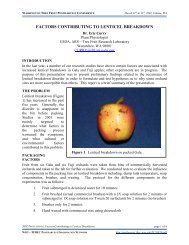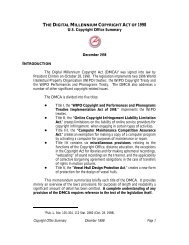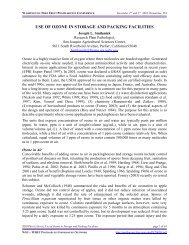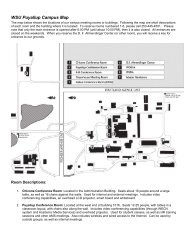Page 1 Chapter 3
Page 1 Chapter 3
Page 1 Chapter 3
Create successful ePaper yourself
Turn your PDF publications into a flip-book with our unique Google optimized e-Paper software.
<strong>Page</strong> 1<strong>Chapter</strong> 3Clinical Assessment and DiagnosisResearch MethodsAssessing Psychological Disorders• Purposes of Clinical Assessment– To understand the individual– To predict behavior– To plan treatment– To evaluate treatment outcome• Analogous to a Funnel– Starts broad– Multidimensional in approach– Narrow to specific problem areas• ReliabilityKey Concepts in Assessment– Consistency is measurement– Examples include test-retest and inter-rater reliability• Validity– What an assessment approach measures and how well it does so– Examples include concurrent, discriminant, and predictive validity• Standardization– Standards and norms help ensure consistency in the use of a technique– Examples include structured administration, scoring, and evaluation proceduresConcepts that determine the value of clinical assessments
<strong>Page</strong> 2Domains of Assessment: The Clinical Interview and Physical Exam• Clinical Interview– Most common clinical assessment method– Structured or semi-structured• Mental Status Exam– Appearance and behavior– Thought processes– Mood and affect– Intellectual functioning– Sensorium• Physical ExamDomains of Assessment:The Clinical Interview and Physical Exam (cont.)Figure 3.2Components of the mental status examDomains of Assessment: Behavioral Assessment and Observation• Behavioral Assessment– Focus on the present – Here and now– Focus on direct observation of behavior-environment relations– Purpose is to identify problematic behaviors and situations– Identify antecedents, behaviors, and consequences• Behavioral Observation and Behavioral Assessment– Can be either formal or informal– Self-monitoring vs. others observing– Problem of reactivity using direct observation methods
<strong>Page</strong> 3Domains of Assessment:Behavioral Assessment and Observation (cont.)Figure 3.3The ABCs of observationDomains of Assessment: Psychological Testing and Projective Tests• Psychological Testing– Must be reliable and valid• Projective Tests– Project aspects of personality onto ambiguous test stimuli– Roots in psychoanalytic tradition– Require high degree of clinical inference in scoring and interpretation– Examples include the Rorschach Inkblot Test, Thematic Apperception Test– Reliability and validity data tend to be mixedDomains of Assessment: PsychologicalTesting and Projective Tests (cont.)Figure 3.4This inkblot resembles the ambiguous figures presented in the Rorschach test
<strong>Page</strong> 4Domains of Assessment: PsychologicalTesting and Projective Tests (cont.)Figure 3.5Example of a picture resembling those in the Thematic Apperception TestDomains of Assessment: Psychological Testing and Objective Tests• Objective Tests– Test stimuli are less ambiguous– Roots in empirical tradition– Require minimal clinical inference in scoring and interpretation• Objective Personality Tests– Minnesota Multiphasic Personality Inventory (MMPI, MMPI-2, MMPI-A)– Extensive reliability, validity, and normative database• Objective Intelligence Tests– Nature of intellectual functioning and IQ– Verbal and performance domainsDomains of Assessment: Neuropsychological Testing• Neuropsychological Tests– Assess broad range of motor, cognitive, memory skills and abilities– Goal is to understand brain-behavior relations (i.e., person’s assets and deficits)– Examples include the Luria-Nebraska and Halstead-Reitan Batteries• Problems with Neuropsychological Tests– False Positives – Saying “you have a brain problem, but you do not”– False Negatives – Saying “you do not have a brain problem, but you do”Domains of Assessment: Neuroimaging and Brain Structure• Neuroimaging: Pictures of the Brain– Allows for a window on brain structure and function
<strong>Page</strong> 5• Imaging Brain Structure– Computerized axial tomography (CAT or CT scan) – Utilizes X-rays– Magnetic resonance imaging (MRI) – Utilizes strong magnetic fields• Greater resolutionDomains of Assessment: Neuroimaging and Brain Function• Imaging Brain Function– Positron emission tomography (PET)– Single photon emission computed tomography (SPECT)– Both involve injection of a tracer substance containing radioactive isotopes; SPECT is somewhat lessaccurate, but less expensive– Radioactive isotopes react with oxygen, blood, and glucose in the brain; blood rushes to active areascreating “hot spots”– Functional MRI (fMRI) – Provides a view of brief changes in brain activity• Advantages and Limitations– Provide detailed information regarding brain function– Procedures are expensive, lack adequate norms– Procedures have limited clinical utilityDomains of Assessment: Psychophysiological Assessment• Psychophysiological Assessment– Methods used to assess brain structure, function, and activity of the nervous system• Psychophysiological Assessment Domains– Electroencephalogram (EEG) – Brain wave activity– Heart rate and respiration – Cardiorespiratory activity– Electrodermal response and levels – Sweat gland activity• Uses of Routine Psychophysiological Assessment.– Disorders involving a strong emotional component– Examples include PTSD, sexual dysfunctions, sleep disorders, headache, and hypertensionDiagnosing Psychological Disorders: Foundations in Classification• Diagnostic Classification– Classification is central to all sciences– Assignment to categories based on shared attributes or relations• Terminology of Classification Systems– Taxonomy – Classification in a scientific context (i.e., entities/things)– Nosology – Application of a taxonomy to psychological/medical phenomena– Nomenclature – Labels that comprise the nosology (e.g., anxiety disorders)Issues with Classifying and Diagnosing Psychological Disorders• Categorical vs. Dimensional Approaches
<strong>Page</strong> 6– Classical (or pure) categorical approach – Strict categories– Dimensional approach – Classification along dimensions– Prototypical approach – Combines classical and dimensional views• Two Widely Used Classification Systems– International Classification of Diseases and Health Related Problems (ICD-10); published by theWorld Health Organization– Diagnostic and Statistical Manual of Mental Disorders (DSM-IV and DSM-IV-TR); published by theAmerican Psychiatric Association• Basic CharacteristicsThe DSM-IV– Five axes describing full clinical presentation (person and environment)– Clear inclusion and exclusion criteria for disorders, including duration– Disorders are categorized under broad headings– Prototypic approach to classification; one that is empirically groundedThe DSM-IV (cont.)• The Five DSM-IV Axes– Axis I – Most major disorders– Axis II – Stable, enduring problems (e.g., personality disorders, mental retardation)– Axis III – Medical conditions related to abnormal behavior– Axis IV – Psychosocial problems affecting functioning or treatment– Axis V – Global clinician rating of adaptive functioning• Other Unique Features of the DSM-IV• The Problem of ComorbidityUnresolved Issues in the DSM-IV– Defined as two or more disorders for the same person– High comorbidity is the rule clinically– Comorbidity threatens the validity of separate diagnoses• Labeling issues and stigmatizationSummary of Clinical Assessment and Diagnosis• Clinical Assessment and Diagnosis– Designed to provide a complete understanding of the client– Designed to aid in understanding and ameliorating human suffering– Requires reliable, valid, and standardized information• Dangers of Diagnosis– Problem of reification
<strong>Page</strong> 7– Problem of stigmatization• Clinical Assessment and Diagnosis: The Core of Abnormal Psychology– A multidimensional perspective of persons who are sufferingConducting Research in Psychopathology• Questions Driving a Science of Psychopathology– What problems cause distress or impair functioning?– Why do people behave in unusual ways?– How can we help people behave in more adaptive ways?Basic Components of Research• Starts with a Hypothesis or “Educated Guess”– Not all hypotheses are testable– Hypotheses in science are formulated so that they are testable• Research Design– A method to test hypotheses– Independent variable – The variable that causes or influences behavior– Dependent variable – The behavior influenced by the independent variableConsiderations in Research Design• Internal Validity vs. External Validity– Internal validity – Confidence that effects are due to the independent variable, and not potentialconfounds• Maturation• History• Regression to the mean– External validity – Extent to which the findings are generalizable• Ways to Increase Internal Validity by Minimizing Confounds– Use of control groups– Use of random assignment procedures• Relation Between Internal and External Validity• Statistical MethodsStatistical vs. Clinical Significance– Branch of mathematics– Helps to protect against biases in evaluating data• Statistical vs. Clinical Significance– Statistical significance – Means the results are beyond chance or coincidence– Clinical significance – Refers to whether the results are clinically meaningful– Statistical significance does not imply clinical meaningfulness
<strong>Page</strong> 8• Balancing Statistical vs. Clinical Significance– Evaluate effect size– Evaluate social validity• Generalizability and the Patient Uniformity Myth• Case Study MethodStudying Individual Cases– Extensive observation and detailed description of a client– Foundation of early historic developments in psychopathology• Limitations– Lacks scientific rigor and suitable controls– Internal validity is typically weak– Often entails numerous confounds• The Nature of CorrelationResearch by Correlation– Statistical relation between two or more variables– No independent variable is manipulated– Range from –1.0 to 0 to +1.0– Negative vs. positive correlation• Limitations– Correlation does not imply causation– Problem of directionality• Epidemiological Research: An Example of the Correlational Method– Incidence– Prevalence– Course of disorders and diseases (e.g., AIDS, extent of trauma following disaster)Hypothetical correlations between age and sleep problemsFigure 3.61
<strong>Page</strong> 9• Nature of Experimental ResearchResearch by Experiment– Manipulation of independent variables– Attempt to establish causal relations• Group Experimental Designs– Control groups: Placebo vs. double-blind controls• Comparative Treatment Designs– Type of group design– Compare different forms of treatment in similar persons– Used to address treatment process and treatment outcomeSingle-Case Experimental Designs• Nature of Single Subject Design– Rigorous study of single cases over varied experimental conditions and time– Repeated measurement and evaluation of variability, level, and trend– Premium on internal validity• Types of Single-Subject Design: Their Nature, Assets, and Liabilities– Withdrawal designs– Multiple baseline designsEvaluation of trend and variability in Wendy’s anxiety via the single-subject design methodFigure 3.7
<strong>Page</strong> 10• Behavioral GeneticsGenetic Research Strategies– Examine interaction between genes, experience, and behavior• Strategies Used in Genetic Research– Family studies – Examine behavioral pattern/emotional traits in family members– Adoptee studies – Allow separation of environmental from genetic contributions– Twin studies – Evaluate psychopathology in fraternal vs. identical twins– Genetic linkage and association studies – Locate sites of defective genes• Rationale and OverviewStudying Behavior Over Time– How does the problem or behavior change over time?– Important in prevention and treatment research• Time-Based Research Strategies– Rationale driving cross-sectional designs – Problem of the cohort effect– Rationale driving longitudinal designs – Problem of the cross-generational effect– Sequential designs – Combine cross sectional and generational designs• Assets and Liabilities of Time-Based Research StrategiesTwo research designs (i.e., longitudinal and cross-sectional designs)Studying Behavior Across Cultures• Value of Cross-Cultural Research: Overcoming Ethnocentric Research
<strong>Page</strong> 11• Assets and Liabilities of Cross Cultural Research– Assets – Clarify how psychopathology manifests in different ethnic groups– Problems with cross-cultural researchThe Nature of Programmatic Research and Research Ethics• Components of a Research Program– Set of inter-related research questions – A tree with many branches– Draw on several methodologies in finding answers– Conducted in stages, often involving replication• Research Ethics: Institutional Review Boards and the APA Ethics Codes– Informed consent – Historical evolution post WWII– Competence – Ability to provide consent– Voluntarism – Lack of coercion– Full information – Necessary information to make an informed decision– Comprehension – Understanding about benefits and risks of participationSummary of Research Methods• Nature of Research: Establishing and Testing Hypotheses• Value of Research Designs Vary Depending on the Questions Posed• Abnormal Psychology Is Founded in the Scientific Method– Understand the nature of abnormality and human suffering– Understand the causes of psychological disorders– Understand the course of psychological disorders– Understand how to prevent and treat psychological disorders• Replication Is the Corner Stone of Science and Programmatic Research• Research Must Occur in the Context of Ethical Considerations and ValuesDiscussion Group 3 – Questions• Identify 3 goals of clinical assessment.• Describe differences between objective and projective approaches to psychological assessment.• What are some components (at least 2) of the mental status exam? Describe…


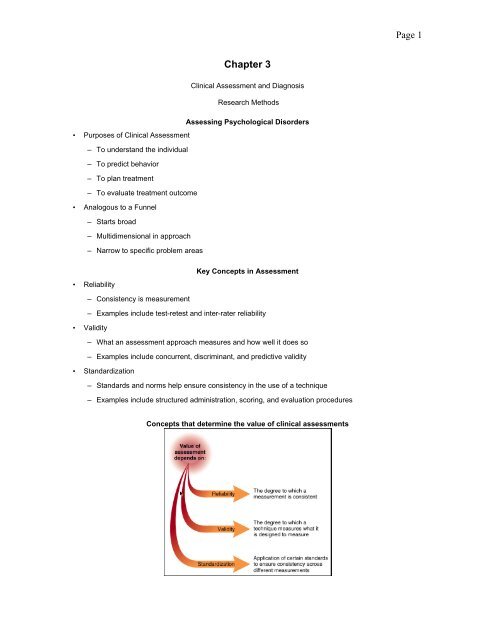
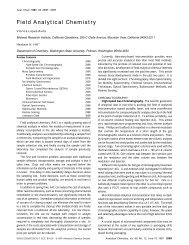

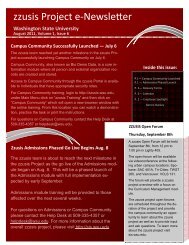
![Graduate School Policies & Procedures Manual 2011 - 2012 [PDF]](https://img.yumpu.com/50747405/1/190x245/graduate-school-policies-procedures-manual-2011-2012-pdf.jpg?quality=85)


